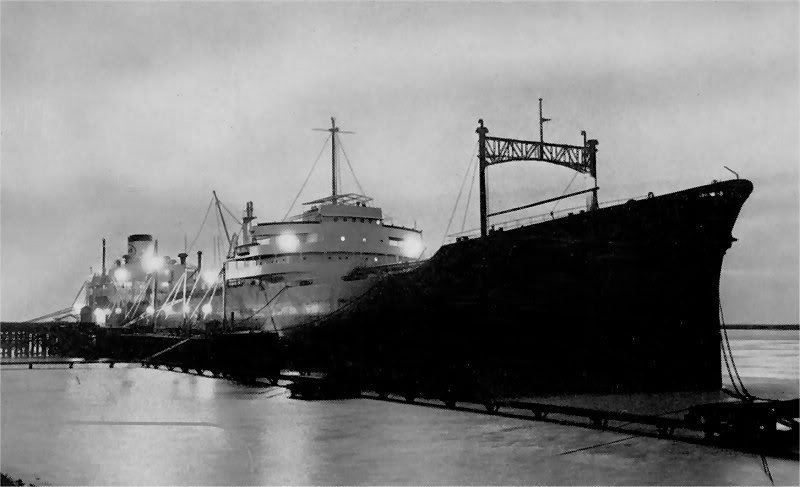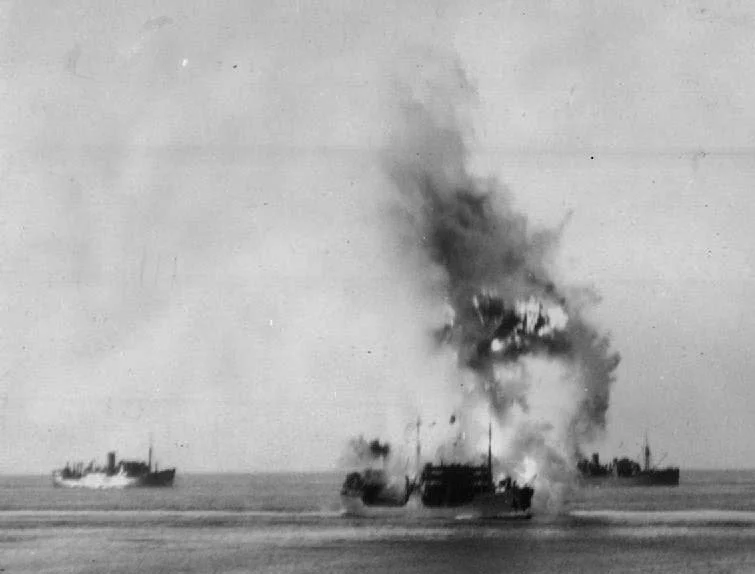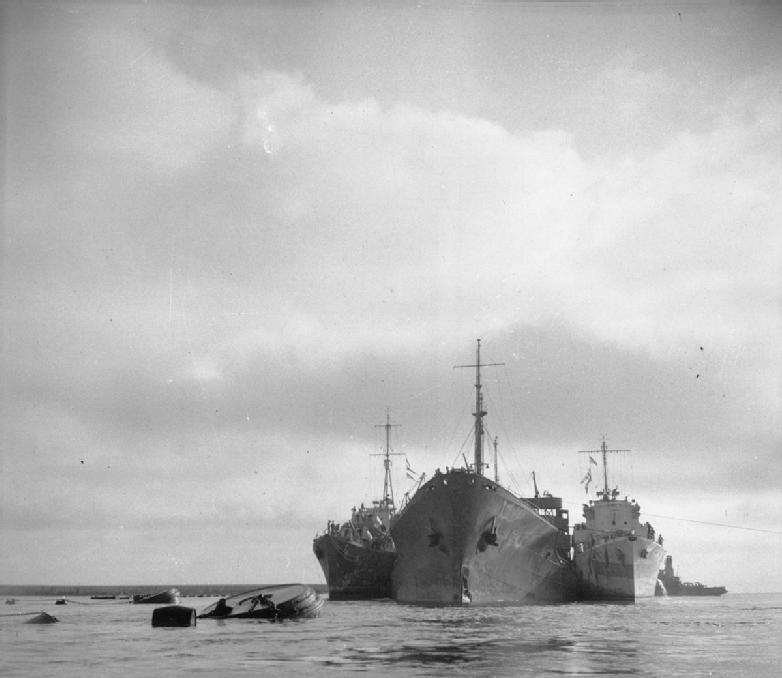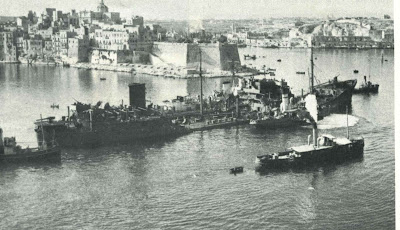The Ship with a Soul

The SS Ohio was built in a Pennsylvania shipyard for the Texaco Oil Company and was completed in 1942. She was an oil tanker of 10,000 tons deadweight and capable of a speed of 19 knots. She was the largest Tanker built at that time. As soon as she was ready for her first voyage she was filled with oil and kerosene and despatched with her Norwegian captain direct to Glasgow to unload her cargo.
When the SS Ohio arrived in Glasgow she was unloaded and her captain expected orders to return to Texas but instead he was told to park the ship in the Clyde. Unknown to him the SS Ohio was being transferred into British ownership and the crew were taken off at a moments notice and replaced by British Merchant Navy seamen. The ship quickly moved to Dunglass on the Clyde where she was given extra strengthening to protect her from exploding bombs. Even the engines were jacked up and Rubber Supports were fitted underneath them to lessen the shock of torpedoes which were the biggest danger for tankers.
Malta, in the Mediterranean, was in a very bad state. There were 9,000 British service personnel on the Island along with 200,000 Maltese and frankly they were starving. Every square yard of soil was put to use in growing vegetables and fruit but it was not enough and previous Convoys carrying foodstuffs had been largely unsuccessful.
When the SS Ohio was ready she was loaded with kerosene and diesel in all her large holds. By this time the British Government had officially taken over the ship under the Emergency Powers Act and it was crucial that she should deliver her cargo to Valetta from where British Submarines were operating. In addition the kerosene was desperately needed for the Spitfires based on the Island. Without fuel they were useless in trying to defend Malta against the daily German and Italian air attacks.
In North Africa and Libya in particular, Rommel was slowly winning the war against British troops and he was trying to capture the Suez Canal. However, Wellington bombers and submarines based in Malta were very successful in sinking German Tankers, thus starving Rommel of the oil that he badly needed to keep fighting. His oil situation was so bad that he halted his advance at El Alemein in an attempt to build up his supplies.
During this period a convoy of 12 British cargo ships was assembled including the SS Ohio and, escorted by 2 Battleships, 4 Aircraft Carriers, 7 Cruisers and 33 Destroyers, and they all set off from Britain to try and reach besieged Malta using the code name Operation Pedestal. By the night of the 10th/11th August 1942 they reached Gibraltar in heavy fog. As they set off on the next leg of the journey a German U-Boat, U73, fired 4 torpedoes and hit the aircraft carrier, HMS Eagle, sinking it with the loss of 260 men. The rest of the crew were saved along with only 4 Spitfires. 36 more Spitfires were flown off another Aircraft Carrier, HMS Furious, and a destroyer rammed and sank an Italian submarine. Although the situation was desperate, the Germans did not give up and they attacked the convoy with a combined force of 120 German and Italian planes.
In the middle of this mayhem, the Italian submarine, Axum, torpedoed the SS Ohio amidships. The ship was on fire and out of control. The engines were shut down and all hands fought the flames. The blast had destroyed the ship’s compass and she could not be steered except from the emergency steering at the rear of the ship. The torpedo had blown a hole 24ft by 27ft in the ship’s port side. The deck had been broken open and the crew could see down into the ship’s bowels.

Then yet another 60 JU87’s attacked the convoy, focussing on the Ohio. A number of near misses buckled the ships plates and the 3-inch gun mounted on the bows was twisted off its moorings. Yet still, the SS Ohio’s guns broke up a formation of JU88’s but one of the attacking aircraft crashed onto the ship’s starboard side and another crashed onto the front deck. The ship turned slowly to COMB torpedoes and two sticks of bombs fell on either side of the Ohio and she was lifted out of the water. She fell back with a huge crash but the rubber mountings saved the engines. Within 20 minutes the SS Ohio was steaming along at 16 knots again. Then another salvo of bombs hit the ship and again the engines stopped. The ship was making alternative black and white smoke until again the engines were re-started. Then she started to lose any forward momentum and stopped.
The crew abandoned ship. The destroyer HMS Penn connected a 10 inch tow rope and strained to tow the Ohio but made no progress. Now both ships were sitting targets and another attack developed. A Destroyer went to full speed to cut the tow rope. A German Bomber dived at the Ohio and released it’s bomb just before it was shot down. The bomb hit the Ohio just where the initial torpedo had hit, breaking her back just as night fell.
Again Ohio was abandoned for the night but early the next day HMS Penn plus HMS Rye towed the Ohio and made 5 knots. A further attack blasted the group of ships, breaking the tow ropes and immobilising Ohio’s rudder. Another bomb hit her front deck as two more attacks narrowly missed the tanker. Once more the ship was abandoned. The two British ships that had shepherded the Tanker were joined by HMS Branham. HMS Rye began to tow the Ohio with HMS Ledbury acting as a rudder but steering proved impossible.
At 1045 the next wave of bombers attacked using oil bombs to try to burn the Ohio. Then 3 more echelons of German planes arrived but, this time, close air support from Malta was available. 16 Spitfires from Malta had sighted the enemy. The first wave of the German formation wavered and broke and the second wave also broke but one group of JU 88’s succeeded in attacking the ship. The Spitfires followed but one bomber held it’s course and a 1,000 lb bomb landed in the ship’s wake. Ohio was flung forward, parting the tow ropes and blowing a great hole in the stern.
Ohio was sinking within 45 miles of Malta. Under the protection of the Spitfires the attacks receded. It was decided to support the tanker with a destroyer on either side of the ship. Speed was increased to 5 knots. Ohio’s deck was awash. She then came under the protection of Malta’s shore batteries who fired at a submarine and a number of German E-boats were driven off.

Slowly the remains of the Pedestal convoy approached the tricky harbour entrance and at 6am Maltese tugs arrived. Destroyers were still attached as the Ohio proceeded into Grand Harbour. There a great welcome awaited them. Huge crowds of Maltese men and women cried as they sang Rule Britannia and a brass band played the tune over and over again. However, it seemed that the SS Ohio was going to sink near the quayside. Suction pipes were hauled on board the ship and emergency pumps began to discharge the kerosene. At the same time the Naval Ship RFA Boxol began to pump out tons of oil into her own tanks.
As the oil flowed the Ohio sank lower in the water at the quayside because the oil was being replaced by seawater via the many holes in the ship. Water has a greater specific weight than Oil so the Ohio became heavier as the oil was removed. After a while the ship settled and broke in two pieces from the damage that she had sustained.

Now Malta had sufficient fuel to carry on it’s battle against the Germans and the Italians. Not only was Rommel denied his Diesel fuel supply but in addition he had lost his last 3 tankers which were sunk by Wellington bombers fitted with torpedoes plus other supply ships which were lost to British submarines.
So, at the end of it’s short life, the SS Ohio, manned by the Merchant Navy, had resisted all attempts to destroy it and, in doing so, had helped to replenish the ammunition that the Eighth needed to repel Rommel from Africa altogether. As a finale, in September 1946, the forward half of Ohio was towed ten miles offshore and sunk by gunfire from the destroyer HMS Virago. On the 3rd October the stern half was scuttled in deep water using explosives. The Royal Navy finished off what the Germans had failed to do. Various parts of the Ohio are preserved in Malta’s National War Museum and a film was made of the whole event called ‘The Malta Story’. Out of the 14 Cargo Ships in the Pedestal Convoy, only 5 ships made it to Malta including the Ohio.
Also we had lost HMS Eagle, the aircraft carrier. After the Diesel fuel was unloaded from the Ohio, some of it was transferred to North Africa in small tankers for use by the Eighth Army, where my Uncle Richard worked on tank recovery. He and others went out at night to recover damaged tanks and brought them in for repair or to be cannibalised. My Uncle used some of the diesel that came from the SS Ohio.